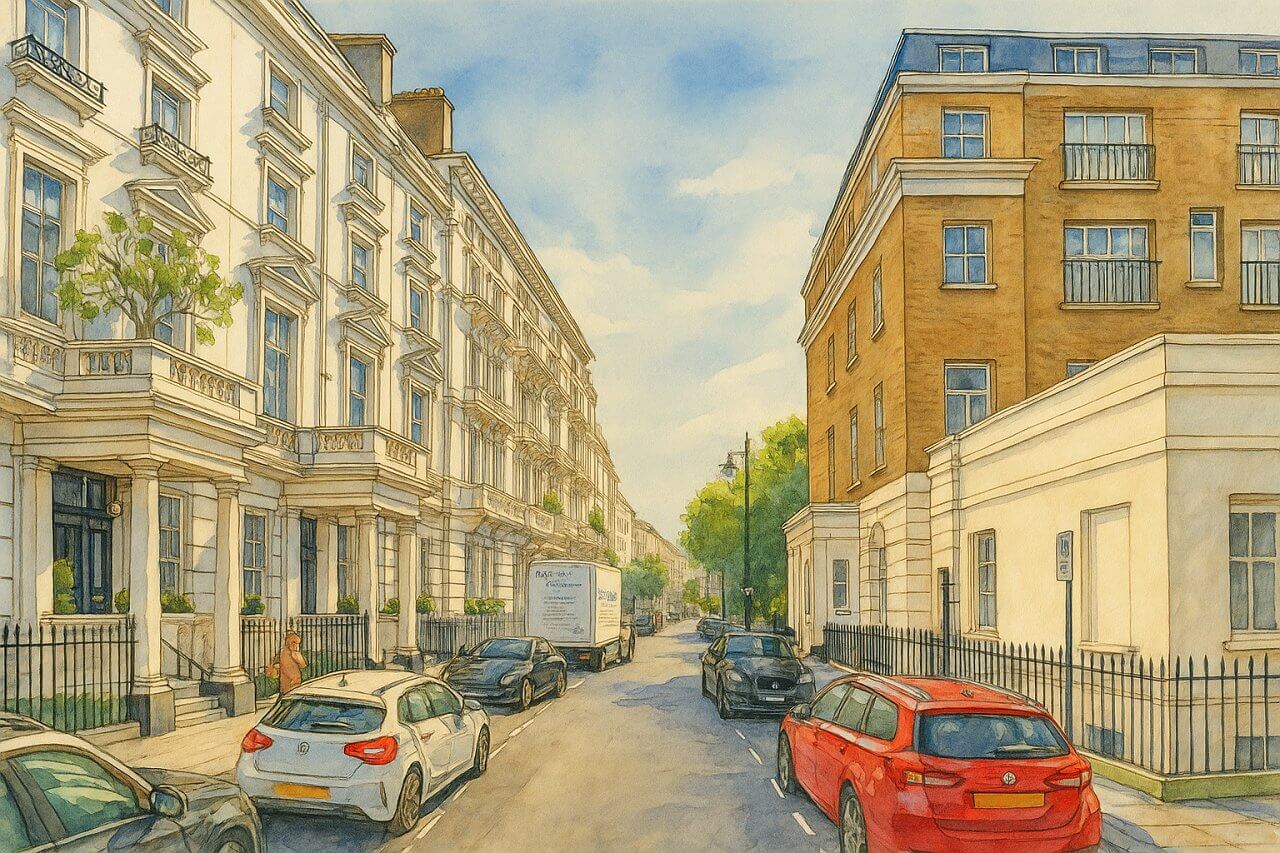
South Eaton Place, London
South Eaton Place is a graceful residential street in the heart of Belgravia, within the City of Westminster. Running southeast from the distinguished Eaton Square to the junction with Ebury Street, it is a short but historically and architecturally rich road that encapsulates the charm of this prestigious London neighbourhood.
Location and Layout
South Eaton Place begins at its northwest end where it meets Eaton Square and continues southeast until it reaches Ebury Street. The road is relatively short, measuring approximately 243 metres (about 797 feet) in length.
The street operates with two-way traffic running northwest to southeast, between Eaton Square and Ebury Street. At the southern junction, vehicles may only turn left into Ebury Street. This is a common traffic management measure in the area to maintain low traffic volumes and preserve the quiet residential nature of the surroundings.
Roads connected to South Eaton Place
- Burton Mews
- Chester Row
- Eaton Mews West
- Eaton Square
- Ebury Street
- Gerald Road
History and Etymology
South Eaton Place was developed as part of the grand Belgravia estate in the early to mid-19th century. The district was transformed from marshland into a fashionable residential quarter under the stewardship of the Grosvenor family, notably Richard Grosvenor, 2nd Marquess of Westminster, with the development largely masterminded by the architect Thomas Cubitt in the 1820s and 1830s.
The name "South Eaton Place" is derived from the adjacent Eaton Square, which itself was named after the family’s ancestral home of Eaton Hall in Cheshire. The street likely received its name in the mid-19th century, soon after its construction. The pronunciation is typically "EE-tuhn" Place, rendered in the International Phonetic Alphabet as /ˈiːtən/. 
Architectural Character
Like much of Belgravia, South Eaton Place is characterised by stucco-fronted terraced houses with classical architectural detailing. These buildings are typically four to five storeys high, often including basement and attic levels, with wrought iron balconies and uniform facades contributing to the elegant, harmonious streetscape.
Most properties here were originally built as single-family townhouses, though many have since been converted into luxury flats and maisonettes. Despite these internal changes, the outward appearance of the buildings remains largely unchanged, thanks to strict conservation rules applied in Belgravia.
Property and Real Estate
South Eaton Place is one of the most desirable addresses in London. As of early 2025, properties on the street typically command prices starting from around £1.8 million for a two-bedroom flat (approximately 1,000 sq ft or 93 sq m), while full townhouses can exceed £15 million depending on size and condition. The price per square foot here regularly reaches £2,000 to £3,000, placing it well above the London average and reflecting its prime central location and exclusivity.
Transport Links
Nearest London Underground Stations
- Sloane Square (Circle and District lines) – approximately 8 minutes’ walk north.
- Victoria (Victoria, Circle, and District lines) – approximately 10 minutes’ walk east.
Nearby Bus Stops
The nearest bus stops to South Eaton Place are located on Elizabeth Street and Ebury Street. These stops are served by several London bus routes, including:
- Bus 11: Heading towards Liverpool Street via Westminster and the City.
- Bus 24: Running from Pimlico to Hampstead Heath.
- Bus 211: Linking Hammersmith to Waterloo via Victoria.
These transport connections make South Eaton Place remarkably accessible for a location renowned for its tranquillity and residential appeal.
Notable Landmarks and Nearby Attractions
While South Eaton Place is itself a primarily residential street, it lies just moments from some of Belgravia’s most attractive destinations. Key sights within easy walking distance include:
- Eaton Square: One of London’s grandest garden squares, lined with diplomatic residences and private members’ clubs.
- Elizabeth Street: Known for its independent boutiques, florists, cafés, and seasonal decorations – a favourite with Instagrammers.
- Pimlico Road: Renowned for its antiques and interior design shops.
- Eccleston Yards: A redeveloped courtyard offering dining, wellness studios, and co-working spaces.
Fun Fact
Despite its serene atmosphere today, South Eaton Place has been home to some notable past residents. One of the most infamous was John ProfumoProfumo scandal in the 1960s. At one point, Profumo had a residence here during his political career.
Summary
South Eaton Place is a quintessential Belgravia street — elegant, refined, and steeped in history. Though small in size, it plays a significant role in the character of this upscale neighbourhood. With its historic architecture, excellent transport links, and proximity to notable attractions, it remains one of the most sought-after addresses in central London.
Quick Facts
- Location: Belgravia, City of Westminster, London
- Length: Approx. 300 metres (985 feet)
- Traffic Flow: One-way northwest to southeast; left turn only onto Ebury Street
- Construction: Early to mid-19th century, part of Belgravia development
- Name Origin: Named after Eaton Square, linked to Eaton Hall (Cheshire)
- Pronunciation: "EE-tuhn" Place /ˈiːtən/
- Property Prices (2025): £1.8M+ for flats, £15M+ for townhouses; ~£2,000–£3,000 per sq ft
- Transport: Nearest stations: Sloane Square and Victoria; Buses 11, 24, 211 nearby
- Nearby Sights: Eaton Square, Elizabeth Street, Eccleston Yards
- Fun Fact: Once home to John Profumo, of the 1960s political scandal
Map of South Eaton Place, London

Painting of South Eaton Place, London (View image in full size)